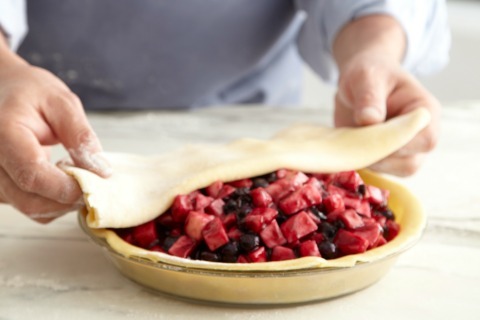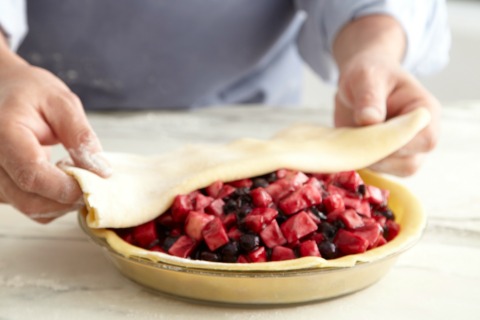3 Easy Ways To Top A Pie: Tips And Techniques
You could say that award-winning cookbook author and Institute of Culinary Education baking program director Nick Malgieri knows a thing or two about pie crust, but that would be a wild understatement. With 12 cookbooks and years of baking and teaching experience, Nick Malgieri is an authority on the subject.
I had the pleasure of talking with Nick about his new cookbook, Pastry: Fool Proof Recipes for the Home Cook (a fantastic collection of more than 125 beautifully-photographed and easy-to-follow recipes), and (since pie-making season is in full swing) about the most important things to know when you're working with pie crust.
Working with pie crust intimidates a lot of home cooks. Can you help us out? What do we actually need to know?
People are wild about trying to get flakiness out of pie dough, but the bottom crust is never meant to be flaky, it's meant to be baked through; that's the most important thing. I like to use baking powder in my dough; baking powder helps the dough expand. If you're baking something that has leavening in it and it also has a filling weighing it down, it's not going to expand upward. So, what it does when the dough expands is really make very intimate contact with the bottom of the pan (which is the source of heat) allowing the bottom crust to be beautifully colored and baked through.
The other thing, which is kind of a no-brainer, is always bake a pie or tart in the bottom rack of the oven; the bottom gets the best heat.
I always hear how important temperature is when working with pie crust. What should I be looking for before I start rolling out the dough?
Temperature is important, especially when butter is involved. Always chill the dough thoroughly if it's going to be rolled out. After a sweet dough has been chilled, knead it on a floured surface until it's malleable again. For a flaky dough, gently press it repeatedly with the rolling pin in a series of parallel strokes in all directions to make it a bit more malleable.
As far as visual and textural cues, you know you're in trouble if the dough starts to look shiny (that means the butter is melting or over-softening) or if the dough is too soft to roll easily.
Let's say I am a total beginner when it comes to pie. Which technique should I try first?
It depends on the kind of pie, but one of the toppings that can be great if you're a beginner is a non-woven lattice pattern. Take 5 strips of dough and lay them across the pie. Then, take another 5 strips of dough and lay them across the pie at a 45-degree angle. This is great because you can see what's happening with the filling. In a fruit pie, for example, you can see if the filling is bubbling nicely and you can even poke a paring knife into the fruit to see if it is tender.
Can you tell me a little bit about your cookbooks and your approach to baking?
One of the things I always do in my books is try to give a range of difficulty. I want people who have never baked to be able to get something out of reading the book but, at the same time, there are a lot of avid bakers out there who are not afraid to attempt something that is a bit of a project.
And, I always caution beginner bakers; don't choose the recipe that's on the cover of the book as a starting place. That's there to draw attention to the book and may not be the best recipe for a beginner. Approach baking gradually.
Ready to try? Here are three easy ways to top a pie from Nick's Malgieri's new cookbook:
Full Top Crust
The key here is to roll the top crust about 1½ inches larger than the diameter of the pie. Once you've done that, you can brush the edge of the bottom crust with water and fold the top crust in half so that it's easier to move and to align with the bottom of the pie.
(Credit: Romulo Yanes)
Unfold the dough so that it covers the pie fully, press thee edges to seal and trim away the excess dough.
(Credit: Romulo Yanes)
Then, fold the top crust over the bottom crust and pinch the edge to flute it.
(Credit: Romulo Yanes)
Diagonal Lattice
Roll the dough so that it is slightly larger than the diameter of the pie. Cut ½-inch-wide strips with a pastry wheel and lay five across the center of a filled pie.
(Credit: Romulo Yanes)
Then, place another 5 strips on the pie at a 45-degree angle. Trip the strips and press them securely to the bottom pie crust.
(Credit: Romulo Yanes)
Woven Lattice
You'll need a small round piece of cardboard to make this lattice pattern; lightly dust it with flour before you begin. Roll the dough so that it is slightly larger than the diameter of the pie. Cut ½-inch wide strips with a pastry wheel and lay them at evenly spaced intervals across the cardboard round. Then, fold every other strip back at its halfway point.
(Credit: Romulo Yanes)
Insert a strip of dough in a perpendicular fashion, unfold the strips so that they cross over and fold the other strips (the ones that are under the perpendicular piece) back at their halfway point.
(Credit: Romulo Yanes)
Insert another piece of dough perpendicular to the others and unfold the strips. Continue in this fashion until you reach the end of the cardboard. Then, repeat the process on the other side of the cardboard.
(Credit: Romulo Yanes)
Chill the lattice in the refrigerator for a few minutes before brushing the edge of the bottom crust with water, sliding the chilled lattice onto the pie, and securing the strips to the bottom crust. Also, be sure to trim the edges of the strips.
(Credit: Romulo Yanes)
For more pastry tips and techniques, buy Nick Malgieri's new cookbook Pastry: Fool Proof Recipes for the Home Cook or visit his website.
Kristie Collado is The Daily Meal's Cook Editor. Follow her on Twitter @KColladoCook.

